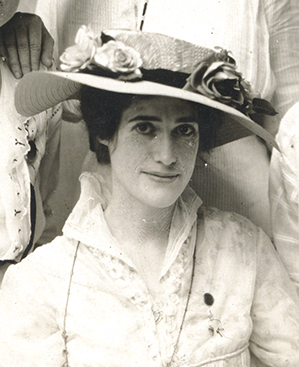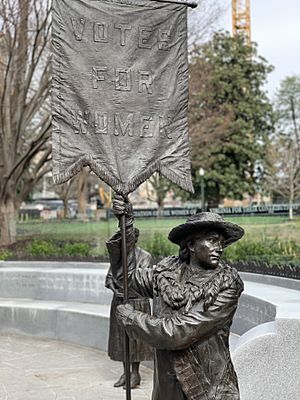Adele Goodman Clark facts for kids
Quick facts for kids
Adele Goodman Clark
|
|
|---|---|

Clark in 1915
|
|
| Born | September 27, 1882 Montgomery, Alabama, U.S.
|
| Died | June 4, 1983 (aged 100) Richmond, Virginia, U.S.
|
| Education | Virginia Randolph Ellett School |
| Alma mater | New York School of Art |
| Occupation | Artist, activist |
| Partner(s) | Nora Houston |
| Parent(s) | Robert and Estelle (née Goodman) Clark |
Adele Goodman Clark (born September 27, 1882 – died June 4, 1983) was an important American artist and activist. She is best known for her work as a suffragist, which means she fought for women's right to vote. She also played a big role in supporting the arts in Virginia.
Contents
Early Life and Art Training
Adele Clark was born in 1882 in Montgomery, Alabama. Her father, Robert Clark, worked for the railroad. Her mother, Estelle Goodman Clark, was a music teacher. Adele had a sister, Edith Clark Cowles, who also became a suffragist.
Her family moved around, living in New Orleans, Louisiana, and Pass Christian, Mississippi. In 1894, they settled in Richmond, Virginia. Adele went to the Virginia Randolph Ellett School. When she was 19, she worked as a stenographer to earn money for art classes. She studied at the Art Club of Richmond.
In 1906, Adele received a scholarship to attend the New York School of Art. There, she learned from famous artists like Robert Henri and William Merritt Chase.
Fighting for Women's Rights
Adele Clark's work as an activist began in 1909. She and 18 other women started the Equal Suffrage League of Virginia. This group worked to get women the right to vote. Adele served as the group's secretary for a year. She also led committees and helped lobby, or talk to, lawmakers in the Virginia General Assembly.
In 1910, she went to a big meeting in Washington, D.C., for the National American Woman Suffrage Association. Adele and her friend Nora Houston found a unique way to spread their message. They would set up their easels on street corners in Richmond. They created "street corner sketches," which were chalk drawings on large rolls of paper. While they drew, they talked about why women should have the right to vote. Adele remembered, "Lots of people made speeches, but we were the only ones sketching, and that really drew crowds." They also handed out leaflets to people who stopped to listen.
Art and Community
In 1917, Adele Clark and Nora Houston opened an art studio together. They called it the "Atelier." Here, they taught art history, painting, and drawing. Many young artists, like Theresa Pollak, learned from them. Two years later, Adele and Nora founded the Virginia Academy of Fine Arts and Handicrafts.
In 1920, when women were about to get the right to vote, there were worries about black women being unfairly stopped from voting. Adele and Nora invited black leaders to their studio to make a plan. They decided that white suffragists would drive around polling places to help. Adele and Nora continued to work for fairness for all people after this election. They also worked to bring back the Academy of Sciences and Fine Arts. This academy reopened in 1930 as the Richmond Academy of Arts, which later became the Virginia Museum of Fine Arts.
When women finally won the right to vote in 1920, the Equal Suffrage League changed its name. It became the Virginia League of Women Voters. Adele Clark was its first leader. She was president of the Virginia League from 1921 to 1925, and again from 1929 to 1944. She also served on the national board of the League of Women Voters. In 1928, Adele and Nora Houston bought a house together in Richmond.
Working in Government
Adele Clark also held important jobs in government and education. She worked for Governor E. Lee Trinkle and Governor Harry F. Byrd. She was also the dean of women at the College of William and Mary.
During the New Deal era, a time when the government created many programs to help people, Adele was a field supervisor for the National Reemployment Service. In 1936, she became the director of the Virginia Arts Project. This project was part of the Works Progress Administration, which created jobs for artists.
She was a member of the Virginia Arts Commission from 1941 to 1964. She had helped create this commission in 1916. Adele Clark believed her art and her activism were connected. She once said, "I've always tried to combine my interest in art with my interest in government."

Later Life
Adele Clark met fellow artist Nora Houston at the Art School of Richmond. Nora became Adele's life partner. After Nora Houston passed away in 1942, Adele's cousin, Willoughby Ions, who was also an artist, moved in with Adele.
Adele Clark continued to be involved in political issues throughout her life. She passed away in a retirement community in Richmond, Virginia, on June 4, 1983, at the age of 100.

